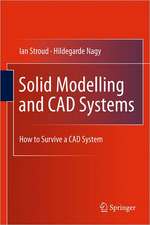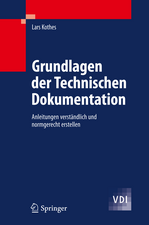Designing Electronic Product Enclosures
Autor Tony Serksnisen Limba Engleză Paperback – 16 dec 2018
Toate formatele și edițiile
| Toate formatele și edițiile | Preț | Express |
|---|---|---|
| Paperback (1) | 546.63 lei 38-44 zile | |
| Springer International Publishing – 16 dec 2018 | 546.63 lei 38-44 zile | |
| Hardback (1) | 735.14 lei 38-44 zile | |
| Springer International Publishing – 9 aug 2018 | 735.14 lei 38-44 zile |
Preț: 546.63 lei
Preț vechi: 674.86 lei
-19% Nou
Puncte Express: 820
Preț estimativ în valută:
104.59€ • 109.50$ • 86.55£
104.59€ • 109.50$ • 86.55£
Carte tipărită la comandă
Livrare economică 02-08 aprilie
Preluare comenzi: 021 569.72.76
Specificații
ISBN-13: 9783030098872
ISBN-10: 3030098877
Pagini: 211
Ilustrații: XXI, 211 p. 56 illus., 25 illus. in color.
Dimensiuni: 155 x 235 mm
Ediția:Softcover reprint of the original 1st ed. 2019
Editura: Springer International Publishing
Colecția Springer
Locul publicării:Cham, Switzerland
ISBN-10: 3030098877
Pagini: 211
Ilustrații: XXI, 211 p. 56 illus., 25 illus. in color.
Dimensiuni: 155 x 235 mm
Ediția:Softcover reprint of the original 1st ed. 2019
Editura: Springer International Publishing
Colecția Springer
Locul publicării:Cham, Switzerland
Cuprins
Introduction and Author’s Credentials.- Outline of Text.- Successful Design.- Building the Design.- Structural Considerations.
Notă biografică
Tony Serksnis began his career in the drafting room of the Lincoln Electric Company running blueprints in 1964. He apprenticed as a tool and die designer while attending night school. After earning a Master's Degree in Mechanical Engineering from the University of Arizona in 1977, he joined the Material Fabrication Group at Lawrence Livermore National Laboratory. Was a part of the design team that built a precision lathe capable of 0.000001 inch accuracy. He then moved on to positions at Intel Corporation, Sytek Corporation, and Trimble Navigation. While at Trimble, he designed products for the Survey and Construction marketplaces. Later, managed Trimble's Mechanical Engineering Group and was responsible for budgeting, resourcing, prioritization, design and documentation, and project management.
Textul de pe ultima copertă
This text explains the process of the design of product electronic enclosures. These products typically contain a printed circuit board. The text takes the reader from the original idea for a product, through the shipment in quantity to a customer. For the product enclosure designer, this proceeds through design layout, material selection, prototype building, testing, and ongoing design improvement.
The book presents a substantive and lucid treatment of the structural, thermal, user-interface, assembly, quality control, and cost considerations of the product enclosure. Of special note is a discussion on the regulatory issues involved with the design of a product. A main thrust of the text is on the "commercialization" aspects of electronic products, that is, when an enclosure is needed for the product to meet environmental and certification requirements globally. The book targets the broadest audience tasked to design/manufacture an enclosure, from mechanical/industrial engineers to designers and technicians. While the intent of the text is not to provide a complete understanding of relevant physical phenomena addressed (strength of materials, shock and vibration, heat transfer), the book provides a ready reference on how and where these key properties may be considered in the design of most electronic enclosures.
Elucidates successful enclosure design for electronic products, defining the design team and the definition of success
The book presents a substantive and lucid treatment of the structural, thermal, user-interface, assembly, quality control, and cost considerations of the product enclosure. Of special note is a discussion on the regulatory issues involved with the design of a product. A main thrust of the text is on the "commercialization" aspects of electronic products, that is, when an enclosure is needed for the product to meet environmental and certification requirements globally. The book targets the broadest audience tasked to design/manufacture an enclosure, from mechanical/industrial engineers to designers and technicians. While the intent of the text is not to provide a complete understanding of relevant physical phenomena addressed (strength of materials, shock and vibration, heat transfer), the book provides a ready reference on how and where these key properties may be considered in the design of most electronic enclosures.
Elucidates successful enclosure design for electronic products, defining the design team and the definition of success
Explains the processes for building enclosures, including printed circuit board layout (mechanical considerations) and optimal object placement, structural considerations, material selection, and user interface design
Includes treatment of serviceability, product environments, standards and testing, cooling techniques as well as guidelines for Electromagnetic Compliance (EMC) standards and testing required to pass FCC/CE
Reinforces design concepts presentedwith relevant solved problems
Caracteristici
Elucidates successful enclosure design for electronic products, defining the design team and the definition of success Explains the processes for building enclosures, including printed circuit board layout (mechanical considerations) and optimal object placement, structural considerations, material selection, and user interface design Includes treatment of serviceability, product environments, standards and testing, cooling techniques as well as guidelines for Electromagnetic Compliance (EMC) standards and testing required to pass FCC/CE Reinforces design concepts presented with relevant solved problems

























